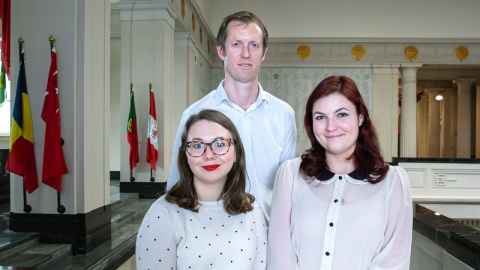Graduate shines light on early Auckland benefactor
18 September 2018
A fresh light has been shone on early Auckland benefactor James Mackelvie.

In a 15,000-word essay to be published in Records of the Auckland Museum, Andrew McKay, one of the first three graduates of the University's new Master of Heritage Conservation specialising in Museums and Cultural Heritage, probes the story of the prolific collector.
"I looked at how the Mackelvie Collection came to be in the Auckland War Memorial Museum and how it was administered by the Mackelvie Trust Board over the last 125 years," says Andrew.
He discovered little had been written about the philanthropist who died in 1885. "Mackelvie came to New Zealand as a junior partner in Brown and Campbell merchants and went on to invest in profitable goldmining ventures in the Coromandel."
"I looked at how the Mackelvie Collection came to be in the Auckland War Memorial Museum and how it was administered by the Mackelvie Trust Board over the last 125 years," says Andrew.
He discovered little had been written about the philanthropist who died in 1885.
"Mackelvie came to New Zealand as a junior partner in Brown and Campbell merchants and went on to invest in profitable goldmining ventures in the Coromandel."
He gifted all his objects to the people of Auckland because he made his fortune here. It was a means of thank you.
Andrew,42, who has had a corporate career and is currently employed by L'Oréal, says his research showed the Mackelvie Board had done a magnificent job in preserving a legacy – "making it visible and available to the people of Auckland".
Andrew is one of three graduands who will graduate with a Master of Heritage Conservation specialising in Museums and Cultural Heritage on 25 September 2018.
23-year-old Madison Pine, who will also graduate, has taken a different tack writing her dissertation on "dark museums" that tell stories of subjects like slavery, genocide and the holocaust.
"I have looked at how three international museums interpreted difficult history for the greatest understanding by their visitors," she says. The three institutions are: The International Slavery Museum in Liverpool; The Apartheid Museum in Johannesburg, South Africa; and POLIN: Museum of the History of Polish Jews, in Warsaw, Poland.
"Personal stories are used a lot in these to give a sense of what it was like to live through histories. Photos and multimedia experiences are also used to help people engage with their history."
Madison says she is really passionate about how people engage and learn about their histories in museums and she can see lots of potential for developing New Zealand history in new ways. She suggests one could be re-looking at the Treaty of Waitangi and its impact on our history.
Erna Battenhaussen, 22, explored an interesting aspect of early New Zealand history when at the end of her Bachelor of Arts in November 2016 she worked at Auckland's Museum of Transport and Technology (MOTAT) as a summer scholar. She researched objects that could form the beginnings of an online Auckland Medical Museum.
Erna was then employed by MOTAT as a research assistant for six months researching and reviewing the health science collection.
"These experiences directly influenced my masters topic," she says. For this she looked at how the process of evaluating any object for a museum collection could be standardised.
During her masters, Erna worked part-time as the Assistant Curator, History at the Auckland Museum. She will begin a full-time, permanent role as a Collections Technician in Documentary Heritage next week.
Media queries
Tess Redgrave | Media Adviser
Tel: 09 923 7383
Mob: 027 562 5868
Email: t.redgrave@auckland.ac.nz